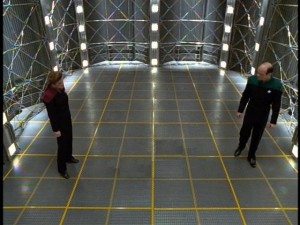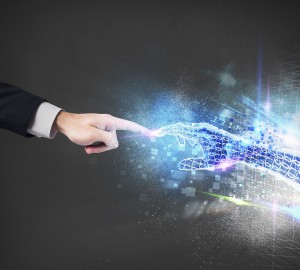The invisible technology behind the homes of our future
The Cambridge Science Festival is running from 7th to 20th March, and to compliment that Dave Coplin, Microsoft UK's Chief Envisioning Officer and speaker, has shared his thoughts on what our homes of the future may look like.
The main way that homes of the future will differ to homes of today is that the technology that will underpin everything we do and how we live will be almost invisible to the people that live there.
Most obviously, there will be no visible screens, devices, keyboards or anything that we would currently  recognise as “tech”. Instead, we will be able to project images onto any surface, interact with technology using voice, gesture and if we have to, via virtual keyboard projected onto surfaces. Actually, I suspect we’ll be able to go further than that by creating something along the lines of Star Trek's HoloDeck whereby we can project 3-dimensional, tactile objects that could create a sun drenched beach in your living room, an artist’s studio in your dining room or a completely immersive world for a video game or movie experience that will feel out of this world.
recognise as “tech”. Instead, we will be able to project images onto any surface, interact with technology using voice, gesture and if we have to, via virtual keyboard projected onto surfaces. Actually, I suspect we’ll be able to go further than that by creating something along the lines of Star Trek's HoloDeck whereby we can project 3-dimensional, tactile objects that could create a sun drenched beach in your living room, an artist’s studio in your dining room or a completely immersive world for a video game or movie experience that will feel out of this world.
But these are the really obvious things that everyone talks about, what I’d rather focus on is some of the things that will happen behind the scenes which will have an even greater impact on our domestic lives.
Algorithms
Already, algorithms are hard at work, trying to make sense of the patterns that define how we human beings behave. It happens today, often when you don’t really notice it, and it exists in the movie recommendations you get from Netflix, the adverts you see on Facebook, or even simply the pre-emptive text you see on your smart phone or when you type in a query to a search engine. These are all examples of artificial intelligent systems trying to deliver greater value to us humans. In the future, this linkage of services and suggestions could go much, much further.
The home as a natural extension of ourselves
Imagine a house that has no light switches, no door handles and no keys. In the AI supported home of the future, the house is a “connected” part of your family and just like any other member of the family, the house will know where you are (whether that’s which room in the house or wherever you may be in the “outside” world), it will know when you’re coming home and will know what you will do when you get home. Knowing all of this information it means the house can start doing some of the heavy lifting for you. 30 minutes before you actually arrive home, the heating in the only rooms you’ll be using can be brought up to your preferred temperature, the lights can be set to your preferred scene and the food from your fridge can be processed and cooked for the time that you want to eat. As you  start your journey home, your house may even contact you to alert you that you’re running low on your favourite chocolate, or that your son just passed his music exam or whatever it might be that may cause you to grab some last minute provisions on your way home. Of course, it’s entirely likely that the house could order them for you and have them delivered before you arrive home, but perhaps it knows that sometimes it’s nice to do things “old school”. Once you’ve arrived at home, as you move around the house going about your domestic business, the house will predict and pre-empt your every move, like a perfect partner, silently ensuring that everything is where it should be, that every facet is accounted for from lighting, to noise levels and heating, without you having to lift a finger. It doesn’t all have to be silent however, we will be able to talk to our houses and ask it questions, advice or give it instructions. The house will be able to answer back and will also be able to “see” us, monitoring our health, heart-rate and diet and to be able to use all of that information to work with us to help maintain both our physical and mental well-being.
start your journey home, your house may even contact you to alert you that you’re running low on your favourite chocolate, or that your son just passed his music exam or whatever it might be that may cause you to grab some last minute provisions on your way home. Of course, it’s entirely likely that the house could order them for you and have them delivered before you arrive home, but perhaps it knows that sometimes it’s nice to do things “old school”. Once you’ve arrived at home, as you move around the house going about your domestic business, the house will predict and pre-empt your every move, like a perfect partner, silently ensuring that everything is where it should be, that every facet is accounted for from lighting, to noise levels and heating, without you having to lift a finger. It doesn’t all have to be silent however, we will be able to talk to our houses and ask it questions, advice or give it instructions. The house will be able to answer back and will also be able to “see” us, monitoring our health, heart-rate and diet and to be able to use all of that information to work with us to help maintain both our physical and mental well-being.
Essentially, this is a world where our homes become a natural, almost living, extension (pun intended) of ourselves. This is a world where our every move and behaviour could be predicted and connected such that we are left free to enjoy the time that we have in the way that means most to us. It doesn’t necessarily mean that the “machines” will do everything for us, but it does mean that the technology could do a lot of the background work if we let it.
Obstacles
Of course, there are a huge number of obstacles to overcome if this is ever to be our domestic future. The most significant of these barriers actually has very little to do with the actual technology, in fact, most of the technology to make this kind of future vision possible is pretty much already here, but the chief limiting factor in our ability to live up to the potential that the technology has to offer will be the human element. The main issue we will need to address is that of trust. Specifically, around being comfortable enough to know that the data that is constantly being generated by our every move will only be used for good and with our consent by third parties that we trust. This includes governments, tech companies, insurers, brands and advertisers.
The second most important factor that will constrain our success is the ambition of the humans that use the technology, and unlike the area of trust, this is the area where I have most of my concerns. Trust issues around data can be relatively easily solved through common sense conversations with all affected parties and complete transparency. Human ambition, however, is entirely more problematic.
Technology as the enabler
I have a relatively simple and possibly naïve view that technology is here to help humans achieve more than they could do on their own. This is why we continue to explore and advance the capabilities of the tools that we have surrounded ourselves with for thousands of years. The issue however, remains that the potential gift of any technological development lies entirely within the hands of the human that uses it and if that human chooses to either ignore the benefit or simply use the benefit to “do less” then the value of the gift is significantly reduced.
In the context of the home then, what this really means is that if the technology becomes more connected and capable of delivering far greater experiences that free up the human to do different things, the real value of that technology can only be measured by the thing that the human chooses to do as a result of the freedom that has been created. If the connected home means that I can spend the majority of my spare time continually binge watching television box-sets or chewing on empty calories of information and gossip from social media then I’m not really sure that we’re living up to the potential that’s on offer. If, however, we make positive conscious choices about how we use that time to better our lives or the lives of those around us, then I think this technology will have had a profound effect in propelling humanity into a place that becomes fit for purpose for the 21st century.
Resources
- What does the home of the future look like? - BBC News
- Technology in the home of the future - Daily Telegraph
 By Dave Coplin, Microsoft Chief Envisioning Officer. Dave was speaking today at the Cambridge Science Festival on "The rise of Humans: at the intersection of society and technology" and the above article is his summary of the thinking that drove his talk.
By Dave Coplin, Microsoft Chief Envisioning Officer. Dave was speaking today at the Cambridge Science Festival on "The rise of Humans: at the intersection of society and technology" and the above article is his summary of the thinking that drove his talk.